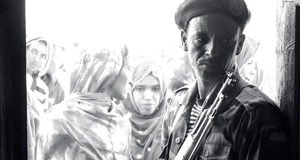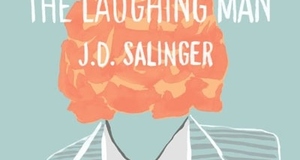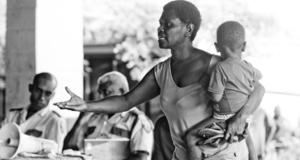"Telepathic Shock" and "The Rush of It All:" Jack Kerouac's Use of Language in On the Road
By
2009, Vol. 1 No. 11 | pg. 2/2 | « Throughout the novel Kerouac transforms weak adjectives into nouns and he does so in the following sentence with “radiancies” which creates a heightened sense of illumination in the language when you preface it with “potent” and “inconceivable” and then follow the verb radiate with “shining in bright Mind Essence”. So essentially we have three words in the language, a noun, verb, and adjective in a row that lead up to the created proper noun of Mind Essence all have meanings to do with light and that reinforces the ideational function of enlightenment in the passage. The last part of this passage, “I could hear an indescribable seething roar” is an interesting clause that follows standard case grammar of subject/verb/object. It is a fascinating use of language to convey feeling of sound without actually using an audible noise. Why I really like this sentence is because it is a complete opposite use of language whereas in other passages Kerouac uses words to convey sound but in this particular sentence he is using the absence of sound as a climatic revelation. For the first time since using the pronoun I twice in the first section of the passage the narrator has come full circle back to addressing himself. What to me, makes it so vivid is the language that follows, “which wasn’t in my ear but everywhere and had nothing to do with sounds”. The whole passage up until that point is internal for the narrator where the language flows in amazing vividness but here we are at the end of the passage and suddenly the ecstasy is no longer a comfortable observation but an “indescribable seething roar” not inside the Mind Essence but levitating around him much like the devil stirring him uncomfortable. It is a meaningful sentence within the novel because the narrator realizes that he isn’t done searching yet for the ecstasy he desires and comes to the revelation that he must keep moving.The following passage is truly a spectacular example of Kerouac’s effective use of language to drive a scene. This scene takes place in San Francisco later in the novel after Dean has been kicked out of his new girlfriends apartment and reunited with Sal again. Together they promise each other to always be best friends and have concocted a plan that will have them hitchhiking from coast to coast again and then move to Italy and explore Europe together. This excerpt is from their last night out in San Francisco before taking off. Within the novel it is a powerful scene because it is their final night on the west coast but more importantly it represents for the characters as well as to the reader the true essence of spontaneity boiled down to the frenetic underground bop scene. This bebop scene evolves over numerous pages and is some of the finest writing in the novel because of the rush and feeling the language conveys through the music it is describing. The behatted tenorman was blowing at the peak of a wonderfully satisfactory free idea, a rising and falling riff that went from “EE-yah!” to a crazier “EE-de-lee-yah!” and blasted along to the rolling rash of butt-scarred drums hammered by a big brutal Negro with a bullneck who didn’t give a damn about anything but punishing his busted tubs, crash rattle-ti-boom crash…The pianist was only pounding keys with spread-eagled fingers, chords, at intervals when the great tenorman was drawing breadth for another blast—Chinese chords, shuddering the piano in every timber, chink, and wire, boing!…He just hauled back and stamped his foot and blew down a hoarse, baughing blast, and drew breath, and raised the horn and blew high wide and screaming in the air…everything came out of the horn, no more phrases just cries cries, “Baugh!” and down to “Beep!” and up to “EEEEE!” and down to clinkers and over to sideways-echoing horn-sounds. He tried everything up, down, sideways, upside down, horizontal, thirty degrees, forty degrees, and finally he fell back in somebody’s arms and gave up and everybody pushed around yelled, “Yes! Yes! He blowed that one!”(OTR 187) From the beginning of the passage the reader is sucked into the language that jives like the bop it is describing. We are quickly introduced to the tenorman blowing at the peak of not a note but a “wonderfully satisfactory free idea”. This “idea” is the new information that sets up the entire rush and novelty of the passage. We are being exposed to something that isn’t specifically revealed but felt through the descriptions of the “idea”. Once it has been established that the reader is witnessing, just like the narrator, something innovative the language begins to pick up and roll like the music. As words become sounds there is a relationship established between the reader through a heightened auditory sense; “a rising and falling riff that went from ‘EE-yah’ to a crazier ‘EE-de-lee-yah!”. Because “EE-yah” and “EE-de-lee-yah” are chopped up syllables representing the sounds the tenorman is playing, the noise to me is conveyed by the capitalizing and stressing the “EE” and connecting the rest of the noise with dashes so as to keep up a rhythmic flow. The use of interjections of language as instruments of sounds is important throughout this passage and scene as the curtain to the “new idea” of bop is being unveiled. Much like a jazz show where the band leader will introduce his musicians the use of language as sound in this passage does the same thing, “a big brutal Negro with a bullneck who didn’t give a damn about anything but punishing his busted tubs, crash rattle-ti-boom crash…”. It’s like a spot light has just swayed from the tenorman to the drummer and in response he crash rattle-ti-boom crash’s. In this excerpt is also the only reference to the race of the band. It should not be taken lightly the race relations that plagued America in the fifties. Kerouac could have easily made the band villainous but he respected and admired the musicians too much for that. The roots of the African American culture were responsible for the “free idea” that we are introduced to and the tribal essence of the passage reflects that. We are introduced to a behatted tenorman squawking out of his horn to a “big brutal negro with a bullneck” where the use of alliteration of three punchy adjectives of “b” words sandwich the revealing information of negro that will reinforce the verb “punishing” and the new information “busted tubs” or drums which then is illuminated by the sound interjections. The effectiveness of this is that choosing to reveal the race of the band with the drummer and making him big and brutal not giving a damn and punishing his drums gives an edge and validity to the band. If we as readers were introduced to a negro tenorman and just his drummer I feel the tendency could have been to focus on the color of their skin not the immediacy of their music. But by revealing their color by using the bruising drummer after the introduction of the tenorman the “free idea” has already been established and the language can now convey the tribal aspects of the pounding drummer who serves as the pulse of the music. Throughout the passage the immediacy of what is being revealed about the bop scene is throughout the language and the introduction to the piano player is no different. He is shown in the immediacy of his playing, with a tenor saxaphone player who is in his own form of ecstasy: “The pianist was only pounding keys with spread-eagled fingers, chords, at intervals when the great tenorman was drawing breadth for another blast—Chinese chords, shuddering the piano in every timber, chink, and wire, boing!” In the first clause of this sentence Kerouac places a subtle “only” that changes the whole dynamic of the clause. By adding the “only” to the clause and giving it a high stress rather then just leaving it at “was” creates a greater sense of urgency to the scene. If I were to follow the formula used to introduce the drummer the passage would go something like, “with spread-eagled fingers only the pianist pounded the keys” but how it stands is more effective because with the new information being “spread-eagled fingers” the language, fueled by the use of “only”, depicts a sort of maniacal but calculated playing. This is reinforced with the word “chord” and how it is isolated without much meaning as the new information to emphasis the pounding of the keys but returns as the old information but more specific as “Chinese chords” becomes the fulcrum in which the language is again able to return to the adjectives that describe the rolling scene that ends with another interjection of sound, “boing!” After we are introduced to the free idea of bop with various linguistic techniques to create the noise of the instruments as well as emphasizing the band and the tribal nature of the music, for me the most meaningful and expressive part of the language is what follows as Kerouac carefully uses his rush of words to bring the reader through the rest of what he would call a “mad scene,” where the energy reverberates through the music and creates a kind of controlled chaos. My favorite sentence in the whole excerpt is, “He just hauled back and stamped his foot and blew down a hoarse, baughing blast, and drew breadth and raised the horn and blew high wide and screaming in the air” because of the immediacy of the language. Six clauses with “he” as their agent subject, all of which have verbs of intense action in music making—“hauled back,” “stamped (his foot),” blew (down),” “drew breath,” “raised the horn” and “blew.” The passage concludes with two more verbs, “baughing” for his “blast,” and “screaming,” a present participle elaborating how he “blew” which ads a more heightened feel to the sentence and the scene. This serves to foreshadow later in the passage when just “Baugh!” is injected by itself. Immediately it is effective because I now think of the sound “baugh” as blasting. But what really gets me in this sentence is the evanescent feel of “raised the horn and blew high wide and screaming in the air”. Textually the decision to not include commas I believe is what makes it so effective because they then become separate independent clauses. By having the horn span the room by top, bottom, left and right, it gives the horn a dominating presence. But also, no longer is it the manipulated brass but an individual character all its own “screaming in the air” commanding attention and respect. The horn and the words it speaks through the language to the reader is a powerful and vivid image. This is reinforced the following sentence, “everything came out of the horn, no more phrases just cries cries, “Baugh! and down to “Beep!” and up to “EEEEE!”. The horn, not the tenorman, has become emotional and the rush of language has shifted focus of the scene from the individuals of the band to the music that has become the centerpiece for the narrator. Then the prose shifts again to the finale of the passage and the new idea that we’ve been introduced to as a reader. “He tried everything up, down, sideways, upside down, horizontal, thirty degrees, forty degrees, and finally he fell back in somebody’s arms and gave up and everybody pushed around yelled, “Yes! Yes! He blowed that one!” What’s so fitting about the language in this final excerpt from one of the most compelling and notable sections of the book is the way the tenorman tried everything. As we are introduced to this new idea the language that reinforces this thought affects us. I could easily see this last sentence starting, He played up, down…etc., but instead the feeling of the bop is boiled down to experimentation, which is the root of spontaneous bop and music. “He tried everything” is a marvelous subject/verb/object clause that is simple in its form but extremely effective within the context of the passage that then reveals to us what the “everything” is and that being every which way the tenorman could try “baughing!” his horn. To punctuate how Kerouac’s language in this passage conveys meaning to the bop scene is the quick blurb of dialog at the end with, “He blowed that one” where he inhibits a snippet of African American Creole dialect to reinforce the tribal aspect of the scene. Jack Kerouac was an innovative writer who dedicated his life to the craft of engaging a reader through the “telepathic shock” of writing with feeling. As his work progressed his prose and use of language became more and more distinct. But in On the Road, his break out novel that gave him the sought after fame he desired, Kerouac’s first use of his original prose is evident. He uses an array of methods such as word repetition, made-up nouns used as adjectives, lack of punctuation to create a sense of immediacy, alliteration for effect, and words as sounds to punctuate musical scenes among many other stylistic choices to create a rush and vivid use of language to portray meaning to the reader. ReferencesGrace, Nancy. Jack Kerouac and the Literary Imagination. Palgrave Macmillion: NY, NY 2007 Hrebeniak, Micheal. Action Writing: Jack Kerouac’s Wild Form. Southern Illinois University: Ill 2006 Theado, Matt. Understanding Jack Kerouac. University of South Carolina Press: 2000 Suggested Reading from Inquiries Journal
Inquiries Journal provides undergraduate and graduate students around the world a platform for the wide dissemination of academic work over a range of core disciplines. Representing the work of students from hundreds of institutions around the globe, Inquiries Journal's large database of academic articles is completely free. Learn more | Blog | Submit Latest in Literature |


















